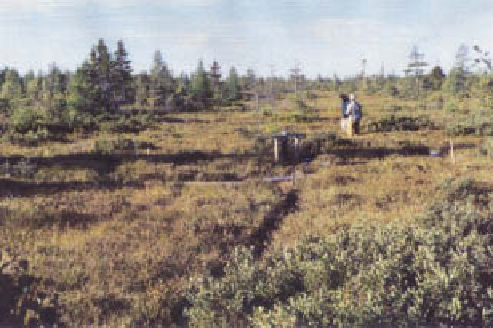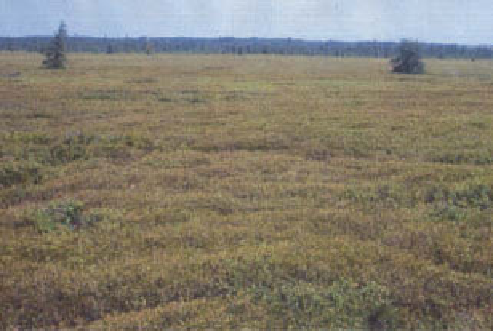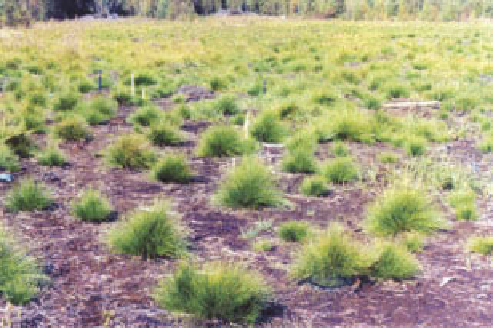Geoscience Reference
In-Depth Information
(a)
(b)
(c)
(d)
Plate 19.6
(a) Pristine ombrotrophic bog, Mer Bleue, near Ottawa, Canada. Vegetation of Sphagnummosses and dwarf shrubs.
on block-cut peatland twenty-five years after abandonment at Shippagan. Ditches blocked after twelve years to speed up
recolonization of plants. (d) Vacuum-harvested peatland at Rivière-du-Loup, Quebec, three years after restoration by straw mulch,
spreading surface peat and raising the water table. Plants are Eriophorum cotton grass, with mosses and shrubs between the
hummocks.
Photos: Tim Moore
reflecting the pressure of carbon dioxide in the atmos-
phere with which the rainwater comes into equilibrium.
There is a close connection between soil pH and the
degree of
base saturation
of the soil colloid complex. The
higher the proportion of the cation exchange sites which
are satisfied by hydrogen (H
+
) and aluminium (Al
3+
), the
lower will be the pH.
Table 19.8
illustrates the terms used
to describe the increasingly acid categories at lower pH,
and increasing alkaline categories at higher pH; the
significant effects on nutrient availability are shown.
When base cations are leached from the soil, the
colloids become saturated with H
+
ions. Around pH 4 the
aluminosilicate clay minerals become unstable, releasing
aluminium ions Al
3+
and silica H
4
SiO
4
4-
. Silica is leached
in solution, but Al
3+
ions attach to clay and humus
surfaces. Hydrolysis of the attached Al
3+
H
+
which causes further breakdown. Thus both alu-
minium and hydrogen are involved in soil acidity.
Soil acidity is probably the most common and
apparently simple test performed on soil. In reality it is a
complex parameter, and determining the pH accurately
is affected by a range of analytical problems. Field pH kits
using indicators and electronic field pH meters are
commonly used, as also are laboratory electronic meters.
The reason for its widespread testing is twofold. First, pH
reflects a range of important soil processes, including
leaching, podzolization, calcification, salinization and
humification. It is also much influenced by fertilizer use
on agricultural soils, for continual additions of inorganic
fertilizers lead to progressive soil acidification. Second, soil
pH has important indirect effects on plant growth.
Figure
19.10
illustrates the relative availabilities of selected
produces more












































